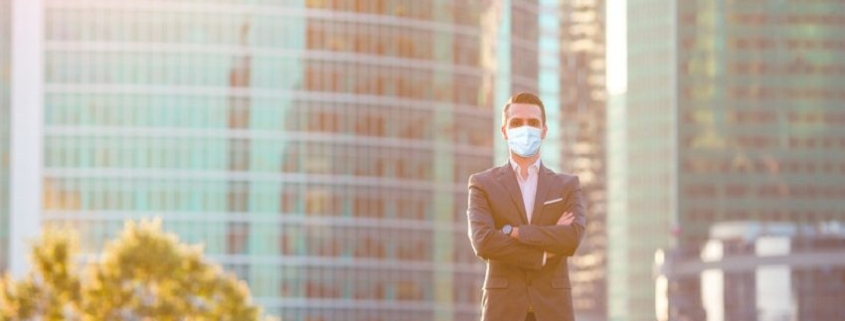Pro Tips From Medical Office Buildings To Avoid COVID-19
Do you own or operate commercial real estate? Do you worry how to keep your properties safe during the crisis caused by the novel coronavirus? You can learn a lot from medical office buildings.
Long before doctors diagnosed the first COVID-19 infection, the owners of medical office buildings were thinking about how to stop the spread of disease. They have even identified a few key renovations that make a difference.
“They exercised a high standard for sanitizing their space, even pre-COVID-19, and are acutely aware of the transmission of infection,” says Joseph Fetterman, executive vice president of Colliers’ Healthcare and Life Science brokerage practice in the Philadelphia region.
Medical office owners and investors have a huge motive to prove that their buildings can operate safely, without spreading the novel coronavirus. As the crisis caused by COVID-19 drags on, businesses that can operate safely are more likely stay open—and keep paying rent.
“We have not seen closures of medical office buildings… We are operating fully in the facilities we manage,” says Kimberly Lamb, executive director of healthcare corporate solutions for JLL. “When most other buildings were shut down, our medical office buildings operated throughout, keeping open to serve the physicians and their patients, albeit with a trimmed back staff for the clinics but they operated the whole time.”
Fresh Air Matters
Because COVID-19 is a respiratory disease, owners of medical office buildings focus on how to keep viral particles out of the air in their buildings. Improving the heating ventilation and air conditioning systems can make a big difference, as can bringing more outside air into structures.
“It is common for the property manager to upgrade filters to MERV-13 and increase fresh air supply,” says Connie O’Murray, managing director of property management for JLL. “So far, however, most managers are not installing systems that use ultra-violet light to disinfect indoor air—they haven’t yet been proven to be effective and are not suitable for all buildings.”
Medical office buildings also ask their patients and staff to wear masks—to filter the air they breathe—and manage how their patients move through buildings. Many medical service providers now ask their patients to register online to bypass the risk posed by crowding into waiting rooms.
“Triage for COVID positive patients is being conducted through telemedicine, outside where possible or in isolated space removed from other patients,” says Fetterman. “Waiting rooms are either more distanced by removing chairs or restricting chairs that can be used.”
“It is all about getting them in to see their doctor and back out as quickly as possible,” says Bob Atkins, principal of the Atkins Cos. in a recent podcast for NREI.
“A lobby registration kiosk could also perform this function,” says Audrey Symes, research director for healthcare and life sciences for JLL.
For some medical offices, that means cutting back on staff who share the air in the limited space of an office. Hospital executives are evaluating which positions can effectively be done remotely on a permanent basis.
“We are hearing potential administrative footprint reduction targets of 50 to 75 percent,” says JLL’s Lamb. “Any vacancy administrative space may create would be absorbed by clinical needs as we move forward.”
Keeping MOBs Clean
All medical offices are disinfecting their spaces to at least the standard set by federal officials at the Centers for Disease Control (CDC).
“Some owners are going above CDC standards for operating the facility to be vigilant,” says Lamb.
Disinfection reaches an even higher level if a patient seems likely to carry the virus.
“When we have a patient who has been reported as presenting positive, we shut down the area and path in which the patient took to allow any spores to dissipate and then thoroughly sanitize the areas before opening back up to the public,” says Lamb.
Property managers are also finding ways to use ways copper metal to kill the virus. Coronavirus particles break apart within hours of landing on copper surfaces. In comparison, they can remain active and lethal for days on surfaces like steel or plastic, according to the Smithsonian Institute.
Owners and operators could replace doorknobs and touch plates with brass, which includes enough copper to kill the virus. But that’s often prohibitively expensive.
“What we have heard about and are seeing is copper foil tape wrap on door handles or placed on touchpoints such as elevator buttons,” says O’Murray.
Managers can also reduce the number of surfaces people have to touch by installing automatic doors or kickplates to open manual doors. In bathrooms, managers can slow down the flush times on toilet and install toilet seats with covers to limit the spread of aerosol droplets into the air, according to O’Murray.
Medical Offices Are Used To Controlling Infections
Long before the crisis caused by COVID-19, the professionals who operate medical office space tried to make sure visitors to their facilities did not make each other sick. Most of the techniques above were developed over the years to avoid “healthcare-associated infections.” The majority of medical office buildings are located on a hospital campus, often physically connected to a hospital.
“This alone creates a different mode of operation and management than any other type of real estate,” says Lamb. “There is a higher level of risk.”
The coronavirus pandemic has heightened the danger. Often people who have tested positive for COVID-19 are in the same building as people who are especially vulnerable to the virus, because of age or a compromised immune system, for example.
“Professionally managed medical office buildings are operated as safely, if not more so, than a typical office building,” says Connie O’Murray. “As our knowledge of the virus evolves over time, so, too, do the approaches and innovations towards mitigation.”
Source: NREI




